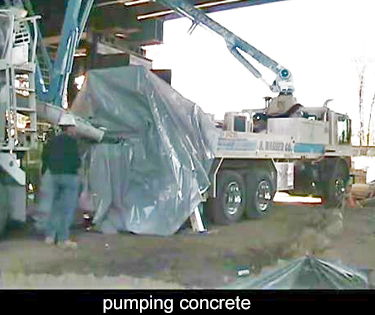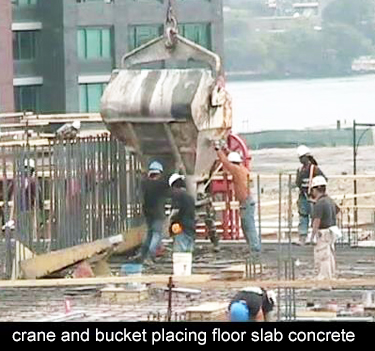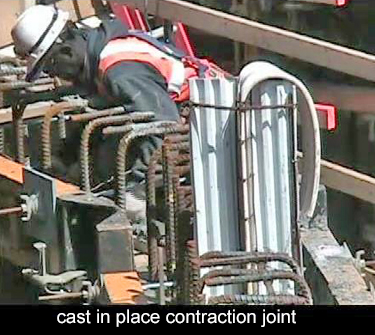We will look at several different techniques for placing concrete. This is a concrete pump, a very effective tool. And you can see the discharge arm is articulated, which allows it to get into very difficult areas. They're placing this concrete underneath an existing bridge. It would be impossible to do this with a crane and bucket. This really would be a challenge, except that the concrete pump makes it very simple.
 Here's the concrete pump. The concrete truck is discharging concrete into it. This pump is covered with some plastic and it must be a brand-new pump and they're trying very hard to keep it from getting dirty, but it's a useless cause. Eventually. it will certainly going to lose its brand new look.
Here's the concrete pump. The concrete truck is discharging concrete into it. This pump is covered with some plastic and it must be a brand-new pump and they're trying very hard to keep it from getting dirty, but it's a useless cause. Eventually. it will certainly going to lose its brand new look.
 Here's a very traditional method, which is a crane and bucket. The concrete truck is filling a bucket. Generally, you would use two buckets, so that while one bucket is being filled or being transported up to the building, the second bucket can be filled. Doing this with a single bucket is really wasting time. The second bucket could be on the ground being filled during this interval. Of course, we've been looking at heavy construction this view is building construction, but the crane and bucket finds many applications in heavy construction as well. I'm using this scene because the backdrop is very impressive.
Here's a very traditional method, which is a crane and bucket. The concrete truck is filling a bucket. Generally, you would use two buckets, so that while one bucket is being filled or being transported up to the building, the second bucket can be filled. Doing this with a single bucket is really wasting time. The second bucket could be on the ground being filled during this interval. Of course, we've been looking at heavy construction this view is building construction, but the crane and bucket finds many applications in heavy construction as well. I'm using this scene because the backdrop is very impressive.
This is a high-rise, concrete frame building and they are placing concrete now in the columns and the walls as an initial operation and then they will follow this by placing concrete on the floor. This looks like an elevator core. The vertical rebar is a wall that, I would say, is enclosing the elevator core. The rebar is in the way of the bucket, so they've constructed some very simple chutes to allow the concrete to reach the wall. They improvise these little devices to help themselves out and it's that kind of know-how that makes for a successful project.
 This is a conveyor belt, something you may not have seen. Here, the laborer put that red marker down on the ground to help him align the truck with the conveyor. The conveyor is a very efficient tool. It has a long reach. It produces a very high volume of concrete. If you're doing a mass pour the conveyor is the fastest possible way of placing concrete. It probably uses a conventional concrete mix. You don't have to use an especially rich mix that you would have to use with a pump. There are many positives for a conveyor. It's spots the concrete exactly where you want It. There is small work force here. Basically, they're just operating vibrators to compact the concrete.
This is a conveyor belt, something you may not have seen. Here, the laborer put that red marker down on the ground to help him align the truck with the conveyor. The conveyor is a very efficient tool. It has a long reach. It produces a very high volume of concrete. If you're doing a mass pour the conveyor is the fastest possible way of placing concrete. It probably uses a conventional concrete mix. You don't have to use an especially rich mix that you would have to use with a pump. There are many positives for a conveyor. It's spots the concrete exactly where you want It. There is small work force here. Basically, they're just operating vibrators to compact the concrete.
I'd like you to take note of the formwork. This wall is formed continuously from one end to the other, as opposed to the alternate pours that I showed you previously. This is a different approach to the work. They are, in fact, placing the concrete in one continuous pour. It certainly cost effective to do it that way. But you need to solve the problem of the shrinkage and you still need intermediate bulkheads. I'll show you how they do it in this system.
That's a vibrator that the labor is lowering into the concrete to make sure it's completely consolidated. This wall is on the opposite side. This was poured the very same day. Now that the concrete is several hours old, they can begin stripping some material that was forming a keyway. It's a very smart to strip it on the same day. If you come back the next day that concrete is set, and it's much harder to remove.
 Now, here's the bulkhead device that I was speaking about. It's different from the effort of installing a bulkhead form, which you can see is time consuming. This has a corrugated shape, which will induce a crack at that location. It also has the water stop attached. In effect, this is producing controlled cracking at regular intervals, without the need to build a bulkhead form and strip a bulkhead form. This is a very cost-effective method.
Now, here's the bulkhead device that I was speaking about. It's different from the effort of installing a bulkhead form, which you can see is time consuming. This has a corrugated shape, which will induce a crack at that location. It also has the water stop attached. In effect, this is producing controlled cracking at regular intervals, without the need to build a bulkhead form and strip a bulkhead form. This is a very cost-effective method.